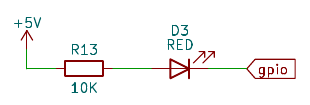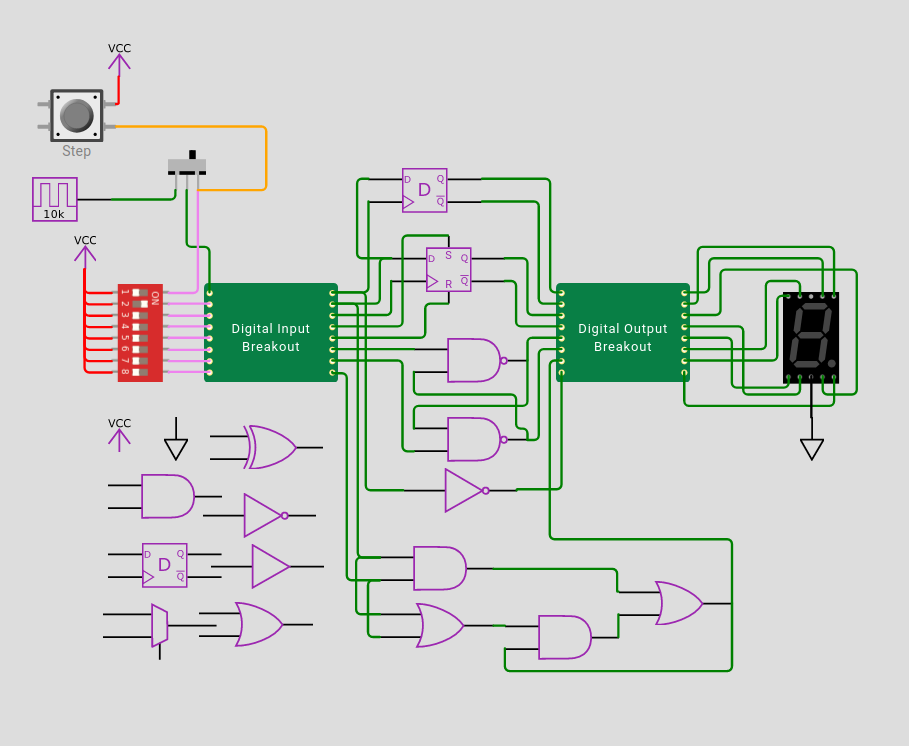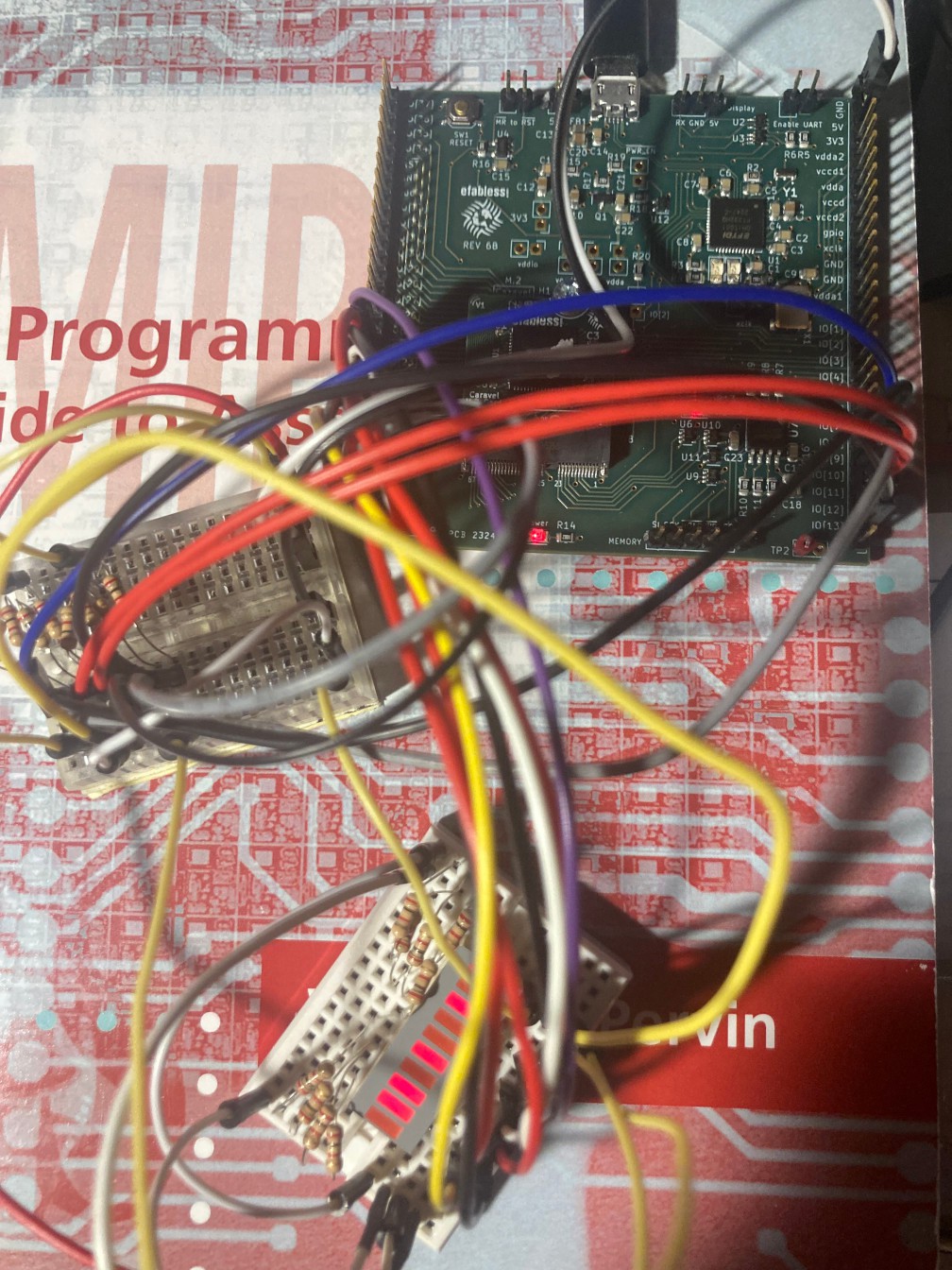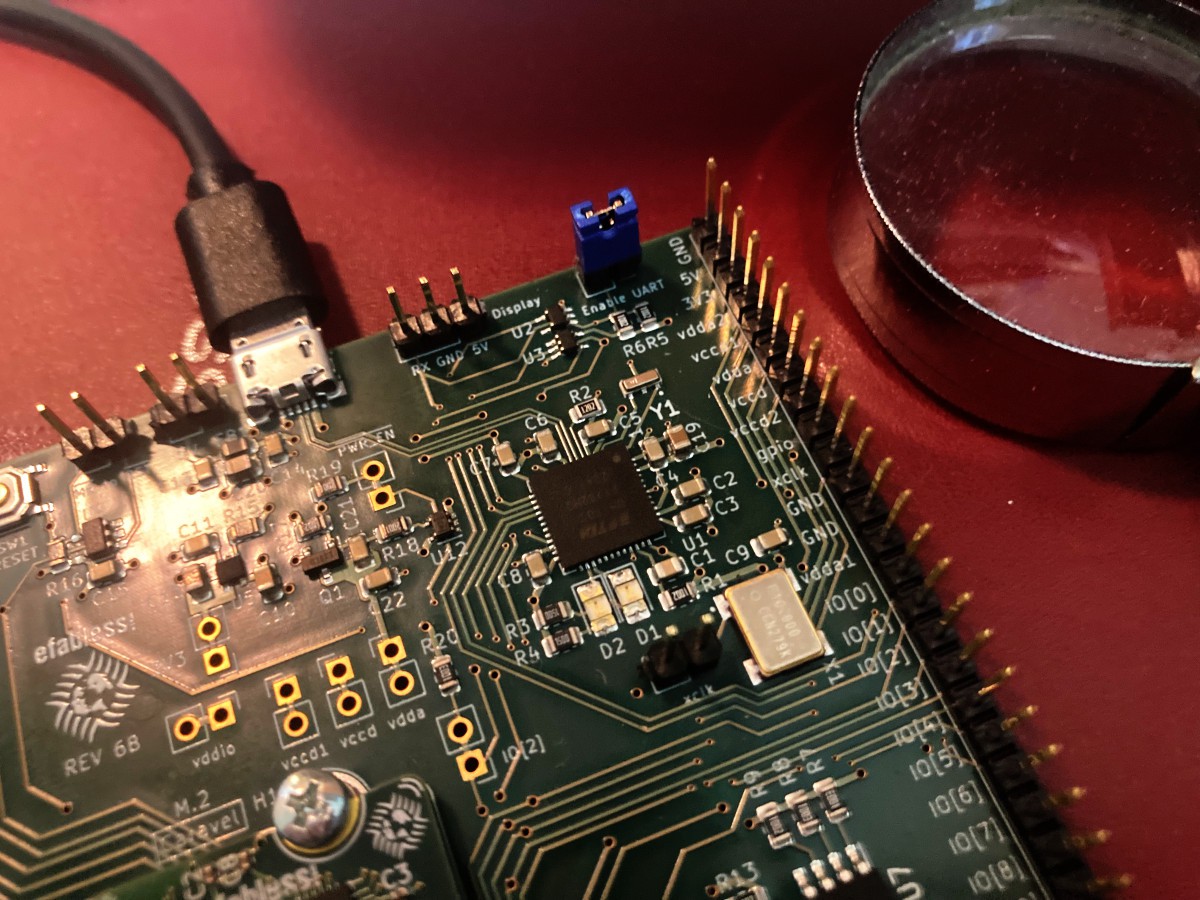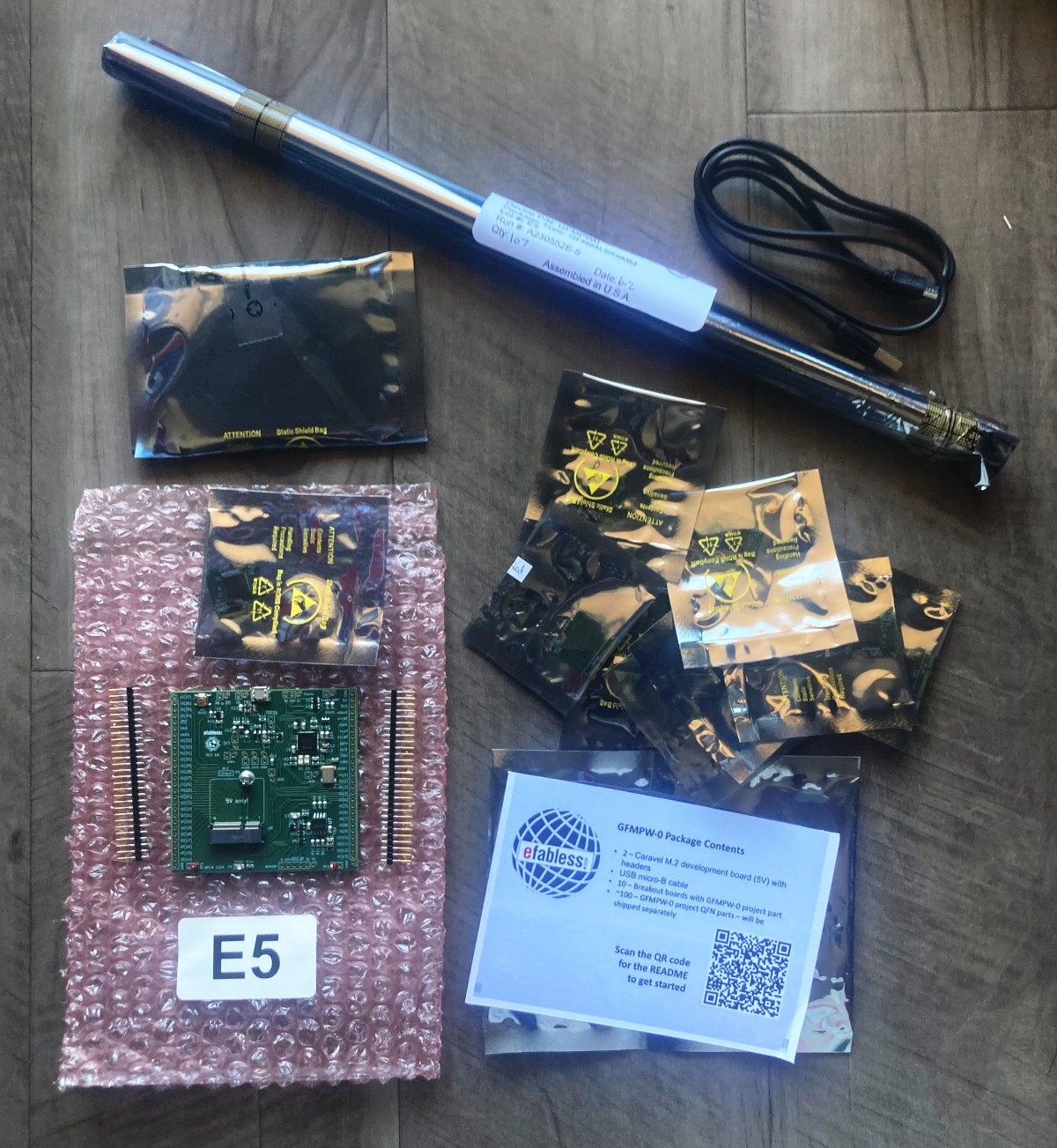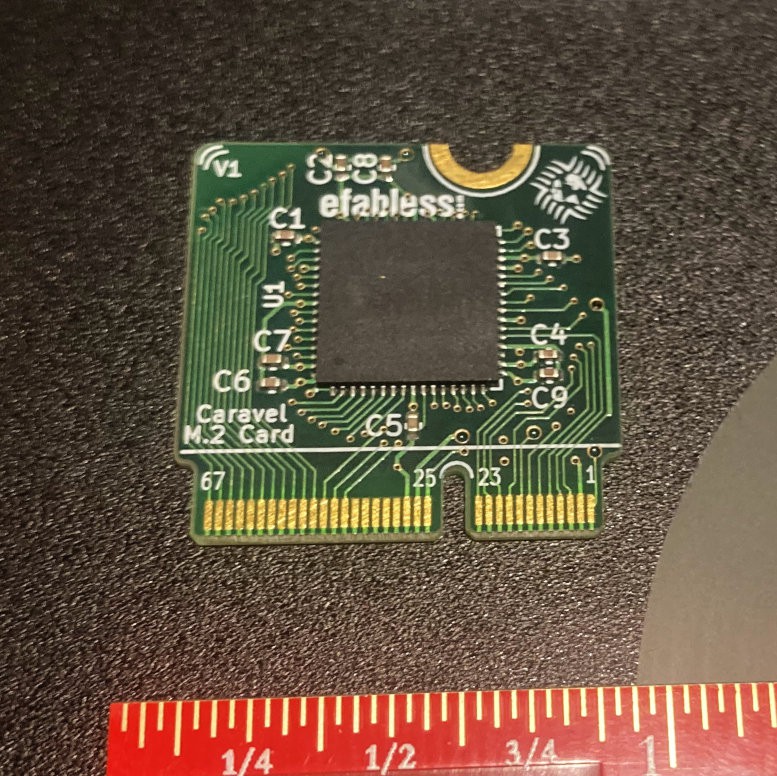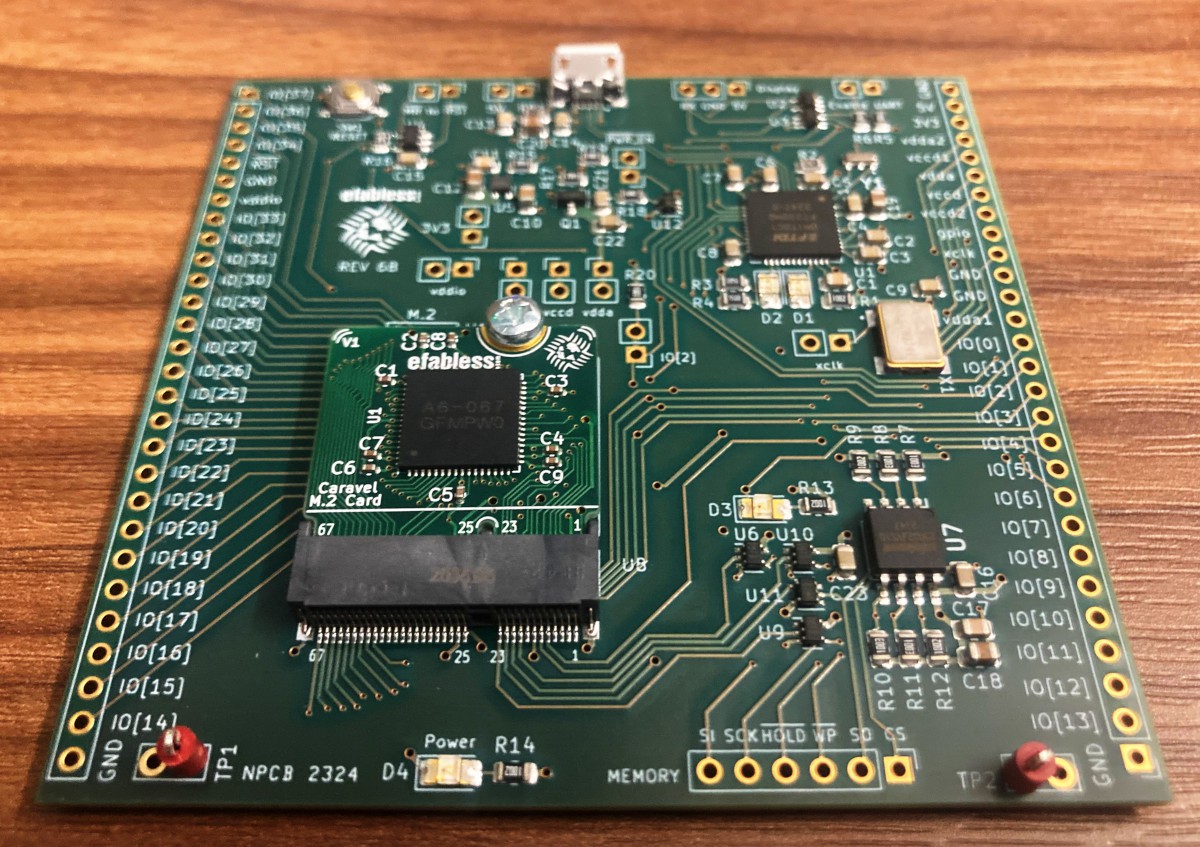-
How to test custom logic part of Caravel chip
08/17/2023 at 06:40 • 1 commentI moved everything needed to my own repo: https://gitlab.com/shaos/marina
For example this is my own location of original blink program:
https://gitlab.com/shaos/marina/-/blob/main/blink/blink.c
If you look into function
void configure_io()you may see how IOs are configured:- from reg_mprj_io_0 to reg_mprj_io_6 (somebody said up to reg_mprj_io_7) are occupied by the system;
- then up to reg_mprj_io_35 could be used by user (and may be even reg_mprj_io_36 and reg_mprj_io_37 - so it's like 30 IOs).
// ======= set each IO to the desired configuration ============= // GPIO 0 is turned off to prevent toggling the debug pin; For debug, make this an output and // drive it externally to ground. reg_mprj_io_0 = GPIO_MODE_MGMT_STD_INPUT_NOPULL; // Changing configuration for IO[1-4] will interfere with programming flash. if you change them, // You may need to hold reset while powering up the board and initiating flash to keep the process // configuring these IO from their default values. reg_mprj_io_1 = GPIO_MODE_MGMT_STD_OUTPUT; reg_mprj_io_2 = GPIO_MODE_MGMT_STD_INPUT_NOPULL; reg_mprj_io_3 = GPIO_MODE_MGMT_STD_INPUT_NOPULL; reg_mprj_io_4 = GPIO_MODE_MGMT_STD_INPUT_NOPULL; // ------------------------------------------- reg_mprj_io_5 = GPIO_MODE_MGMT_STD_INPUT_NOPULL; // UART Rx reg_mprj_io_6 = GPIO_MODE_MGMT_STD_OUTPUT; // UART Tx reg_mprj_io_7 = GPIO_MODE_MGMT_STD_OUTPUT; ... reg_mprj_io_37 = GPIO_MODE_MGMT_STD_OUTPUT; // Initiate the serial transfer to configure IO reg_mprj_xfer = 1; while (reg_mprj_xfer == 1);
At the end of the function you can see how it sets those configuration values to the actual hardware. Before calling this function it's also setting up the only GPIO pin (that is connected to LED in efabless "mother" board):
reg_gpio_mode1 = 1; reg_gpio_mode0 = 0; reg_gpio_ien = 1; reg_gpio_oeb = 0;It's basically means OUTPUT and it must be OUTPUT (inverted indication):

Then to switch LED On we need to write there 0 and to switch LED Off we need to write there 1:
while (1) { reg_gpio_out = 1; // OFF reg_mprj_datah = 0x0000002a; reg_mprj_datal = 0xaaaaaaaa; // delay(50000); delay(2000000); reg_gpio_out = 0; // ON reg_mprj_datah = 0x00000015; reg_mprj_datal = 0x55555555; // delay(50000); delay(2000000); }Here also clearly visible way to program IOs - reg_mprj_datal covers lower 32 bits, and reg_mprj_datah cover higher 6 bits (if it's defined as inputs you can read from those variables as well).
In this case on-board custom logic is not connected to anything - everything is controlled by RISC-V programmatically, but what if we need to connect IOs to user custom logic? Then IOs must be configured to one of this settings:
// GPIO_MODE_USER_STD_INPUT_NOPULL // GPIO_MODE_USER_STD_INPUT_PULLDOWN // GPIO_MODE_USER_STD_INPUT_PULLUP // GPIO_MODE_USER_STD_OUTPUT // GPIO_MODE_USER_STD_BIDIRECTIONAL // GPIO_MODE_USER_STD_ANALOGBut then Caravel RISC-V will not be able to read or write IOs, so what can be done to programmatically write user inputs and read user outputs? TinyTapeout discord user anish experimentally found bits that need to be set for this:
#define GPIO_MODE_MGMT_CONTROLLED_IO 0x00F #define GPIO_MODE_USER_CONTROLLED_IO 0x00ESo we set user custom design inputs to GPIO_MODE_MGMT_CONTROLLED_IO and user custom design outputs to GPIO_MODE_USER_CONTROLLED_IO (Note: I gave those macro names. Names proposed by anish were different). Now we can build custom tester of on-board custom logic:
https://gitlab.com/shaos/marina/-/blob/main/shaos_test1/main.c?ref_type=heads
-
Start with Caravel
07/27/2023 at 07:13 • 0 commentsInitially efabless motherboard had this blinking program flashed into memory:
https://github.com/efabless/caravel_board/blob/main/firmware/gf180/blink/blink.c
That program works like this:In order to clean the flash we need to use option 6 from caravel_hkdebug.py:
> python3.8 caravel_hkdebug.py Success: Found one matching FTDI device at ftdi://ftdi:232h:1:52/1 Caravel data: mfg = 0456 product = 20 project ID = 0c002c69 project ID = 4b1a0018 ----------------------------------- Select option: (1) read CARAVEL registers (2) read CARAVEL project ID (3) reset CARAVEL (4) reset Flash (5) read Flash JEDEC codes (6) start flash erase (7) check flash status (8) engage DLL (9) read DLL trim (10) disengage DLL (11) DCO mode (12) full trim (13) zero trim (14) set register value (q) quitthen chip is switched to user defined logic - in my case it was this simple test circuit:

This circuit was prepared with Wokwi online schematic editor and simulator:
https://wokwi.com/projects/348540666182107731
You can check Verilog output of this circuit using this Wokwi API URL:
https://wokwi.com/api/projects/348540666182107731/verilog
This Verilog was used for manufacturing of my version of the Caravel chips:
https://github.com/shaos/tiny_silicon_1
Apparently everything was working as expected:

but better to use Caravel chip itself to test the logic - in this case we need to write a program that will produce some inputs, read some outputs and print some logs - Motherboard+Caravel is able to use serial communication with PC on speed 9600 that is enabled when this jumper switch in installed:

and we need to remove the jumper to flash SPI memory because both serial connection and flashing use the same FTDI chip.
Next project log will describe special program to test the logic from the chip itself...
-
GFMPW0 package
07/26/2023 at 05:55 • 0 commentsEach GFMPW0 project that efabless sent to the authors has 1 USB-cable, 2 mother-boards, 10 daughter-boards and 100+ chips in QFN64 package:

Caravel daughter-board uses edge connector that is called "M.2 Keyed E":

This daugther-board is inserted into special socket on the mother-board:

Official motherboard from efabless also has SPI-Flash memory 4MB where you have a program for RISC-V and FTDI-chip to connect to PC over USB-cable - special Python program could be used on PC to program the Flash (I'm gonna fix some issues with this to make it more compatible with different forms of hex-files) and another Python program can get some info from the chip as Project ID, read registers etc. See official repos from efabless with all source-codes of firmware, utils, cores and boards:
https://github.com/efabless/caravel_board/tree/main/firmware/gf180
https://github.com/efabless/caravel_mgmt_soc_gf180mcu/tree/main
https://github.com/efabless/caravel_board/tree/main/hardware/development/caravel-5V-dev-v6-M.2
Lab Computer "Marina"
How many Caravel chips does it take to make a usable lab computer for debugging digital electronics? Let's find out...
 SHAOS
SHAOS